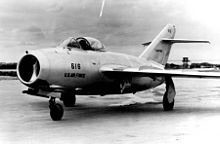No Kum-sok
No Kum-sok (later Kenneth H. Rowe , born January 10, 1932 in Sinhung , North Korea ) is a former lieutenant in the North Korean Air Force. On September 21, 1953 , he passed over to the South Koreans in his MiG-15bis, a version of the MiG-15 , and thus brought the first fighter jet of this type into the possession of the NATO countries and their allies.
Desertion in 1953
The staunch anti-communist No joined the North Korean Naval Academy - despite secret escape plans - in order to enjoy a university education. He passed his training as one of 80 cadets and was accepted into the North Korean Air Force in order to be trained as a fighter pilot by Soviet trainers in Manchuria .
Through numerous articles about his flying skills and his enthusiasm for communism in newspapers and party magazines, he achieved a certain fame at this time. He later said that he was "living a gigantic lie in hiding under the protective garb of the communist state."
On the morning of September 21, 1953, No, then 21, flew from Sunan Airport near Pyongyang to the Kimpo base not far from the border at the 38th parallel. His flight across the border initially went unnoticed, as the US radar systems had been temporarily switched off for routine maintenance. In South Korea he also saw his mother again, who had fled the north in 1951.
No later received a reward of $ 100,000 for handing over the enemy aircraft type advertised by the United States in Operation Moolah. But he does not want to have known about this, he fled "sick and tired of the red deception".
Further life
In 1954, No emigrated to the United States , where he applied for US citizenship, changed his name to Kenneth H. Rowe, and studied mechanical and electrical engineering at the University of Delaware . He later worked as an aerospace engineer for well-known companies such as General Motors , Boeing and General Electric . No married a North Korean emigrant with whom he has two sons and a daughter.
meaning
In November 1950, the Soviet Union introduced the MiG-15 series fighter jets. On the part of NATO, these were known and feared primarily because of their progressive construction. In April 1953, the USA therefore set a reward of 100,000 US dollars (then 420,000 DM , in today's purchasing power around 1,100,000 euros ) for the first pilot of the Eastern Bloc and his allies to bring an intact MiG into the possession of the US Army brought out to subject them to a comprehensive technical analysis and flight evaluation. Nos MiG-15bis was brought to Okinawa, where "Tom" Collins and Maj. "Chuck" Yeager completed the first test flights. The aircraft was then dismantled and in December 1953 - reassembled - flown to Wright-Patterson Air Force Base. Although the US offered to return the MiG to its rightful owner, no country claimed the aircraft, so it was given to the US Air Force National Museum in 1957.
In 1996 No published the book "A MiG-15 to Freedom" (in the original: "A MiG-15 to Freedom" ), in which he writes about his life in North Korea and his desertion . His defection also found its way into a mission in the video game Chuck Yeager's Air Combat .
See also
Individual evidence
- ^ Keith Zenobia: Pine Mountain Lakes Aviation Association Newsletter. (PDF; 1.6 MB) September 2004, accessed on August 1, 2014 .
- ↑ historicwings.com
- ↑ a b National Museum of the US Air Force ( memento from September 22, 2013 in the Internet Archive ) about their exhibit (English)
| personal data | |
|---|---|
| SURNAME | No, kum-sok |
| ALTERNATIVE NAMES | Rowe, Kenneth H. |
| BRIEF DESCRIPTION | North Korean pilot, lieutenant in the North Korean Air Force |
| DATE OF BIRTH | January 10, 1932 |
| PLACE OF BIRTH | Sinhung , North Korea |

